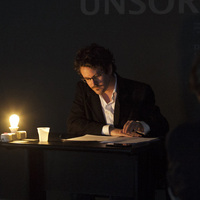
Troy Bordun
Assistant Professor in the English Dept. at the University of University of Northern British Columbia. Formerly a contract instructor at Trent University (Cultural Studies, Sociology), Concordia University (Art History, Communication Studies, Sociology and Anthropology), and Bishop's University (English and Film Studies).
In 2015, I completed my PhD in Cultural Studies at Trent University.
My current research interests include film theory, genre, spectatorship theory, contemporary art cinema, sexuality in the cinema, pornography, and continental philosophy.
I was a film-programmer for Trent Film Society.
In 2015, I completed my PhD in Cultural Studies at Trent University.
My current research interests include film theory, genre, spectatorship theory, contemporary art cinema, sexuality in the cinema, pornography, and continental philosophy.
I was a film-programmer for Trent Film Society.
less
Related Authors
Timothy Willem Jones
La Trobe University
Tina Kendall
Anglia Ruskin University
Matthew Broome
University of Oxford
Aaron Gerow
Yale University
Mark Deuze
University of Amsterdam
Dylan Trigg
Central European University
Murat Akser
University of Ulster
Andrea Peto
Central European University
Martin Lefebvre
Concordia University (Canada)
Benjamin Noys
University of Chichester
InterestsView All (34)










Uploads
Books by Troy Bordun
to take up an analysis of stars-as-sounds. In “On the Off-Screen
voice: Falling in Love with Her,” Bordun reflects on the ways in which
the play on Johansson as star and as voice in the film is essential to the
perceived romantic authenticity at the heart of the film. Exploring the
place of sound within classic narrative form and realism, Bordun takes up
Spike Jonze’s Her as a film that at once complicates but ultimately reasserts
established relationships of sound to image within narrative cinema.
Within this discourse, Bordun further implicates the Star, exploring how
iconicity forms through the perception of embodied attributes—even
when a visible or physical body is withheld. (Preface, Monaghan, Stevens, and Loreck)
Film Studies Articles and Chapters by Troy Bordun
This article provides an overview of the Fifty Shades of Grey reviews published in the popular press at the time of the film’s release on Valentine’s Day Weekend 2015. Through a careful look at the reviews, I assess which genre references resonated with critics. In my reading of the Fifty Shades criticism, given that the film was neither art, nor porn, nor schlock, the only low genre left for critics to assess it was the “woman’s film.”
Article is available for free in the provided link.
Link above, under "URL."
I first consider how her pornography is unlike the erotic. Sexual encounters within her films are rife with dissatisfaction and misery and therefore far from the definition of viewing erotic art as a composed spectator’s aesthetic appreciation. Second, I articulate the difference between Breillat’s films and a pornography designed to titillate a male viewer. The sensation Breillat produces in spectators is a narrative displeasure. With this method of sensorial provocation, calling the viewer to ethically respond to the work by engaging their senses, Breillat transmits her message. She accomplishes this cinematic brilliance – treading a line which is pornographic yet not erotic and causing a sensation in the viewer which is not arousal – by frustrating habituated viewing, challenging the common film-experience of identifying with characters or symbolically recognizing the genre. With her misuse of pornography Breillat’s films achieve their social and political function.
Keywords: Catherine Breillat, Pornography, Linda Williams, Christian Metz, Laura Mulvey, Feminism, Sexuality, Genre.
to take up an analysis of stars-as-sounds. In “On the Off-Screen
voice: Falling in Love with Her,” Bordun reflects on the ways in which
the play on Johansson as star and as voice in the film is essential to the
perceived romantic authenticity at the heart of the film. Exploring the
place of sound within classic narrative form and realism, Bordun takes up
Spike Jonze’s Her as a film that at once complicates but ultimately reasserts
established relationships of sound to image within narrative cinema.
Within this discourse, Bordun further implicates the Star, exploring how
iconicity forms through the perception of embodied attributes—even
when a visible or physical body is withheld. (Preface, Monaghan, Stevens, and Loreck)
This article provides an overview of the Fifty Shades of Grey reviews published in the popular press at the time of the film’s release on Valentine’s Day Weekend 2015. Through a careful look at the reviews, I assess which genre references resonated with critics. In my reading of the Fifty Shades criticism, given that the film was neither art, nor porn, nor schlock, the only low genre left for critics to assess it was the “woman’s film.”
Article is available for free in the provided link.
Link above, under "URL."
I first consider how her pornography is unlike the erotic. Sexual encounters within her films are rife with dissatisfaction and misery and therefore far from the definition of viewing erotic art as a composed spectator’s aesthetic appreciation. Second, I articulate the difference between Breillat’s films and a pornography designed to titillate a male viewer. The sensation Breillat produces in spectators is a narrative displeasure. With this method of sensorial provocation, calling the viewer to ethically respond to the work by engaging their senses, Breillat transmits her message. She accomplishes this cinematic brilliance – treading a line which is pornographic yet not erotic and causing a sensation in the viewer which is not arousal – by frustrating habituated viewing, challenging the common film-experience of identifying with characters or symbolically recognizing the genre. With her misuse of pornography Breillat’s films achieve their social and political function.
Keywords: Catherine Breillat, Pornography, Linda Williams, Christian Metz, Laura Mulvey, Feminism, Sexuality, Genre.
KEYWORDS: Online pornography, porn stars, pornography history, online communities, fan studies
Apr. 17, 2018: Six Films About Non-Monogamous Relationships that Don't Suck;
May 1, 2018: Here's What's Wrong with the "Porn is Dangerous" Argument;
May 31, 2018: A Guide to Wonder Woman's Kinky History;
June 26, 2018: 5 Questions with Filmmaker and Pornographer Bruce LaBruce;
July 22, 2018: This Film About Camming Tears Down the Sex Industry's Red Tape
August 24, 2018: Two New Women-Led Films Explore Desire and Gender
October 11, 2018: Cassandro the Exotico is Wrestling Homophobia Out of the Ring, with Style
Nov. 7, 2018: The Gay Erotic Thriller "M/M" takes Toxic Masculinity to Task
Nov. 28, 2018: This New Book Offers a Fresh Take on Polyamory
Aug. 9, 2019: A New Film's Lynch-y Take on Youth, Sexuality, and Perversion
Oct. 24, 2019: Videophobia Confronts Consent in the Digital Age
Wednesday, August 22nd – Friday, August 24th, 12:00pm-9:00pm
An installation of films playing simultaneously throughout the gallery:
Auguste and Louis Lumière's First Films, France, 1895-1900
Dziga Vertov’s Kino-Eye, Soviet Union, 1924
Jonas Mekas’ Walden: Diaries, Notes and Sketches, U.S.A., 1969
Peter Greenaway’s The Falls, Wales, 1980
Chris Marker’s Sans Soleil, France, 1983
Friday, August 24th :
6:30pm: Reception with food and drink;
7:30pm: Closing remarks;
8:00pm: Keynote speaker, Dr. Davide Panagia (Cultural Studies, Trent University), “Hume, Cinema, and the Politics of Discontinuity”.
French documentary filmmaker Chris Marker has passed away, but not without leaving us myriad films to remember him by. Known for his early sci-fi photo novel La jetée (1962), later remade into Twelve Monkeys (1995) by Terry Gilliam, The Last Bolshevik (1993), about Soviet life and filmmaker Aleksandr Medvedkin, and his last feature The Cast of the Grinning Cat (2004), Marker, according to Jean-Pierre Gorin, will be remembered as the most interesting and original film-essayist of our time.
We have put together a series of films, including Marker's Sans Soleil (1983), as an homage to the recently departed, as a selection of his possible influences, and as a project in theorizing non-narrative cinema in general. By non-narrative we mean a film that has its beginning not in story, plot, or script, but in the images themselves and as curators of this exhibition we want to explore the use of cinema as a means of collecting and cataloguing images. In order to do this we have selected several films that take, variously, the forms of diaries, travel notes, reports, and letters. In putting these films together we hope to show some of the ways in which cinema has (or has tried to) work outside of the narrative tradition that has defined most of its history.
Things that Quicken the Heart is a three-day installation of films that will run each day for a nine hour period (12:00pm to 9:00pm) and will consist of several films playing on loop throughout the gallery space. Visitors will be encouraged to watch the films in any order and for any length of time – the films are meant to be viewed not as totalities composed of fragments but as fragments composed of fragments, and so a complete viewing is unnecessary, though it would not hurt. It is merely for the curators to provide the space and for the visitors to decide what is at stake in each depiction.
On Friday evening, August 24th, the exhibition will conclude with a reception and remarks from the curators as well as a keynote speaker, Dr. Davide Panagia (Cultural Studies, Trent University). Dr. Panagia's talk, “Hume, Cinema, and the Politics of Discontinuity”, thinks about the ways in which all film is in fact non-narrative and in its apparent discontinuity, is a superb tool for political resistance. Following his address there will be an open discussion.
In the second part, I'll think more carefully about exactly how she performs, linking those early films to her latest, Marriage Story.
While the ideas presented in this video are somewhat broad, I'm indebted to the work accomplished by the scholars featured in Screening Scarlett Johanson: Gender, Genre, Stardom, published by Palgrave MacMillan in early 2020. My chapter on Her and sound technologies can be found therein.
In this video essay I tried to bring together these elements of Reygadas's oeuvre. We see these themes in the deaths of animals and humans, the consistent depiction of guns, and the ties between religiosity and sex and death. In my reading of the director's work, seemingly incongruous scenes can be connected to help us understand more about Reygadas's place within contemporary film-making and his view of life in contemporary Mexico and, if we're lucky, we may also come to understand ourselves a bit better too.
Video from Reygadas's Japón (2002), Battle in Heaven (Batalla en el cielo, 2005), Silent Light (Stellet Licht, 2007), and Post Tenebras Lux (2012).
A short essay on animals, non-human animals, and death is available here: troybordun.wordpress.com/2015/06/25/mexico-is-bleeding-the-films-of-carlos-reygadas-video-essay/
A very early attempt at teasing out death and dying in Reygadas's cinema can be found here: vimeo.com/101023277
In another sense, Rouch meant that the camera enables individuals to perform. We see this in films as diverse as Steven Soderbergh’s Sex, lies and videotape (1989), Ulrich Seidl’s Jesus, You Know (2003), and Werner Herzog’s Grizzly Man (2005). These works – one fiction and two documentary – demonstrate that the camera is not merely for commonplace testimonies nor a medium which allows spectators to identify with performers’ emotions. The camera, while asking or commanding persons in front of the lens to perform, is also like a therapist.
Cameras and therapists are alike in their silent and non-judgmental nature, a nature which allows performers to divulge their secrets, desires, and confessions. The technology is silent, thereby providing an uninterrupted time and space for performers to bring their psyches to language and to work out a problem for themselves. The added benefit of being recorded is that it demands an individual to perform not just everyday life, but reflect on the fact that in speaking and acting for the camera, everyday life is a performance.
Full text here: troybordun.wordpress.com/2014/10/02/video-essay-camera-confessionalcamera-therapist/
Trent Film Society is excited to present an exhibition of moving-image pornography up to 1972. We begin with the photographer Eadweard Muybridge and his pictures from the 1880s of nude bodies in motion. From there we transition to the silent cinema. From 1905-1930, explicit shorts of copulating bodies were shown at stags for men’s enjoyment. In the decades to follow, there was a brief lull of moving-image pornography. It was not until the 1960s that naked bodies reappear on the screen. Nudie cuties, sexploitation, art films, and blaxploitation flicks brought sex back to the cinema. These films were the pre-cursor to the hard core genre. Hard core pornography broke into the mainstream with Gerard Damiano’s Deep Throat in 1972. Deep Throat was the first pornographic film to receive attention from both men and women alike, and the film entered popular consciousness, not without controversy.
We hope our exhibition presents a history too often unacknowledged. The proliferation of moving-image pornography is not a recent phenomenon – sex has always been part of the cinema. We also hope that spectators can draw connections between this history and our present day production and consumption of pornography.
At our exhibition a number of films will be screened and posters, screenshots, and other promotional materials will be on display.
For more information visit: facebook.com/trentfilmsociety; email: trentfilmsociety@gmail.com
With footage from:
Behind the Green Door (1972) dir. The Mitchell Brothers
Boys in the Sand (1971) dir. Wakefield Poole
Deep Throat (1972) dir. Gerard Damiano
Eugenie (1969) dir. Jess Franco
I am Curious Yellow (1967) dir. Vilgot Sjöman
Justine de Sade (1972) dir. Claude Piersan
Loves of a Blonde (1965) dir. Miloš Forman
Quiet Days in Clichy (1970) dir. Jens Jørgen Thorsen
The Good Old Naught Days (2002) dir. Cécile Babiole, Michel Reilhac
The Immoral Mr. Teas (1959) dir. Russ Meyer
Women in Love (1969) dir. Ken Russell
You can find my article on Marvel Comics' Domino in the Canadian Review of Comparative Literature.
First, this presentation provides an overview of the Fifty Shades of Grey reviews published in the popular press at the time of the film’s release on Valentine’s Day Weekend 2015. In my reading of the Fifty Shades criticism, given that the film was neither art, nor porn, nor schlock, the only low genre left for critics to assess it was the “woman’s film.” The woman’s film designation allowed critics to denigrate the film and provide disparaging commentary about it to thereby prop up their authority and demonstrate their good taste. The designation of woman’s film does little to account for both the men in the audience as well as the character namesake of the film. To more convincingly comprehend and condemn the film’s problematic depictions of psychological and sexual abuse, instead of attacking its misrepresentations of BDSM practices, I evaluate the film within the context of what I coin as the upper-class white male fragility cycle in contemporary Hollywood. I read this cycle through two film posters and two trailers. I situate the film within an existing regime of signs whose meaning is comprehensible and appealing to a wide audience. It is producers’ and critics’ knowledge and perpetuation of this regime of signs that make Fifty Shades so culturally troubling.
In this paper I argue that Reygadas’s Post Tenebras Lux (2012) presents altered states of embodiment “as if” they were everyday experiences, first, for the fictional characters, and second, for spectators’ bodily experience of the film’s reality. Reygadas offers us a difficult narrative film that is any combination of characters’ dreams, fantasies, and hallucinations. Narrative films usually treat altered states as mental rather than physical experiences, reinforcing Cartesian views of experience. Unlike narrative works that clearly mark a separation between the “real world” of the diegesis and a subjective reality unique to a character, Post Tenebras Lux refuses to do so. By not announcing which sequences are dreams, concepts, and fantasies, and through an aesthetics that aims to elicit bodily responses in viewers rather than character identification/empathy, such as depth of field, the “hyperbolic long take” (de Luca 2014), and a camera lens shaved flat so that the edges of the frame are blurred, the director constructed a film that allows spectators to feel “as if” in an altered state themselves. This aligns the film with Maurice Merleau-Ponty’s one-world hypothesis (Lingis 1996). For the phenomenologist, embodiment is a continuous flow of experience, thus dreams and fantasy are parts of being-in-the-world, not cordoned off states of mind. Media theorist and phenomenologist Vivian Sobchack (2004 & 2014) helps to reinforce these claims. She argues that films can touch us bodily, thus when we utter statements such as “the film felt ‘as if’ real,” we really mean that the film made contact with our corporeality. I conclude that Reygadas’s aesthetics turns viewers back on themselves to sense, and reflect upon, experiences otherwise unacknowledged as essential components of embodiment.
Pornographic genre codes are appropriated by Breillat and twisted to produce a particular message, meaning, or truth: the shame of feminine sexuality under patriarchy. In this paper I argue she must be pornographic if some element of truth in obscenity is to be recovered. I situate Breillat within a style of cinematic pornography, recuperating the term from otherwise hostile definitions.
I first consider how her pornography is unlike the erotic. Sexual encounters within her films are ripe with dissatisfaction and misery and therefore far from the definition of viewing erotic art as a composed spectator’s aesthetic appreciation. Secondly, I articulate the difference between Breillat’s films and a pornography designed to titillate a male viewer. True, Breillat falls in with pornography defined by Williams as a body genre, producing intense sensations in the spectator; pornography, in some manner, should move the viewer, often to a state of arousal. How an individual is precisely moved is where Breillat greatly separates herself from hard core. The sensation Breillat produces in spectators is a narrative displeasure. With this method of sensorial provocation, calling the viewer to ethically respond to the work by engaging their senses, Breillat transmits her message. She accomplishes this cinematic brilliance – treading a line which is pornographic yet not erotic and causing a sensation in the viewer which is not arousal – by frustrating habituated viewing, challenging the common film-experience of identifying with characters or symbolically recognizing the genre. With her misuse of pornography Breillat’s films achieve their social and political function.
In this article, I argue that Tsai Ming-liang’s narratives of ruin are also stories of enduring love. By situating characters in ruinous environments in The Hole (1998) and The Wayward Cloud (2005), we see the falling away of civility and morality. In these settings, unable to band together for collective action, the protagonists do not battle for scarce resources but accept their positions and lead bland, bleak, and solitary existences. However, with the emotionally and sexually unfulfilled protag-onists of The Hole and the stalled sexual encounter of The Wayward Cloud, Tsai seems to argue for an account of love more attuned to Alain Badiou’s philosophy: love is obstinate and a powerful unchanging element surviving “catastrophic existence.” I read these two films intratextually through the generic conventions of the musical-romantic-comedy and demonstrate that Tsai's films answer Badiou’s call to rally to the defence of love.
Published in Studies in European Cinema... [see the "Papers" section of my Academia profile]
In this paper I argue that actors and actresses’ performances are key objects of analysis in addressing the ethical challenges of New Extreme films. Breillat's Fat Girl (2001) and its fictionalized making-of, Sex is Comedy (2002), incites an ethical engagement not merely in the sense of textual analysis, but requires a deeper investigation inherent to the filmmaking process. The reflexivity of the paired films – the latter as a staged re-enactment of the sex scene of the former, re-performed by lead actress Mesquida - motivates the development of a theory of performance following Linda Williams' reflections, and in so doing shifting emphasis from director-auteur to the equally important actor-auteur, as Dyer argued decades ago.
Breillat places high demand on her actors to perform (physicality) as well as act (deliver dialogue), evinced by Mesquida's reluctance and difficultly in shooting the twenty minute scene in which her character, Elena, is coerced out of her virginity in Fat Girl, and its alternate but similar re-performance in Sex is Comedy. The unnamed character-actress of the latter bursts into sobs when director Jeanne finally utters “cut” after the long take. Her tears are powerful within the narrative to be sure, but reflexivity is used here as a method of rethinking Mesquida's earlier role in addition to films of the New Extremism generally, as Breillat is an oft-cited name for the recent cinematic tendency for flesh and blood: it poses the question of whether onscreen acts of physical and emotional violence manifest in the bodies of actors and actresses off-screen, and further, to what aesthetic and ethical end. In making the parallel between the films (hitherto unaccomplished by scholars) I sidestep theorists who label New Extremism aesthetic pornography or transgressive cinema, and instead refocus the theorizing of these films to issues of performance, the actor-auteur, and ethics.
In this paper I present Bataille on laughter and its merits as a philosophical project. Laughter is an experience to be theorized and a praxis aiding in our pursuit of truth and an ethical life. At its limits a body produces laughter – the rollercoaster ride, high-risk rescue, la petite mort – and the threshold of existence is torn asunder to reveal the absurdity of serious behaviour and thinking. Seriousness: planned futures, workdays, major and minor worries, fear of self-harm in helping others, any element that composes our stable identity. The seriousness in our lives disappears during fits of laughter, an exhaustive experience linked to death, and because of its proximity to destruction, in laughter Bataille finds knowledge of what we are as human bodies: beings composed of finite matter brought into existence by chance and as chance existences no more valuable than another human life. I will discuss and extend Bataille’s work which describes laughter and philosophical thinking as the same, the former held in higher regard for its ability to provide a richer understanding of what the copula to be entails: an affirmation of life through giving ourselves to others. "
Also presented at Snickering Scholars, Humor and the Humanities Graduate Student Conference, York University, March 16, 2012
Published as Genre Trouble and Extreme Cinema: Film Theory at the Fringes of Contemporary Art Cinema, Palgrave MacMillan, 2017